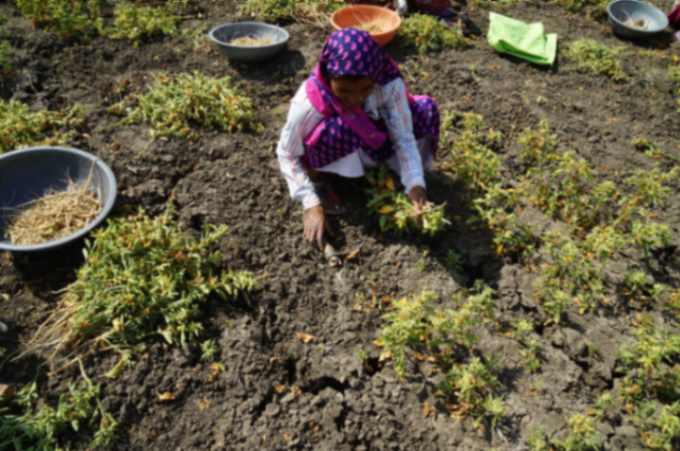In February, I traveled to India to resume my ongoing investigation into the herb ashwagandha (Withania somnifera), which I have previously researched in both the north and south of the country. But this time, I was going to see a specific source—from field to extraction.
India is home to the 5,000-year old system of medicine known as Ayurveda, whose name means “Science Of Life.” Under this ancient approach to healthcare—which includes dietary therapies, massage, yoga, and more—the main medicines are herbs, as many as 7,500 of them. Among those herbs, ashwagandha is considered the most valuable of them all, and is known as the king of herbs.
Starting out in Massachusetts, I flew halfway across the world, landing in the chaotic city of New Delhi. There I met with Kartikeya Baldwa of the company Ixoreal, whose sole product is an extract called KSM-66® Ashwagandha Root Extract. Certified organic and backed by more than 15 human clinical studies showing its benefits, KSM-66® is exactly the kind of exceptional herbal extract that I seek for the formulas Purity Products® and I develop. Herbal extracts are like any other product; they can be of high or poor quality and can either be beneficial to health or effectively useless. Many factors go into the outcome. Purity and I set a high bar for ingredients, because we want people who use our products to gain real health benefits. In Kartikeya’s company, I planned to see for myself the entire chain of production of KSM-66®.

Ashwagandha: The King Of Herbs
Ashwagandha can be found in the wild from Africa to the Mediterranean, and East into India where it took hold more than 4,000 years ago as a valuable health aid. The name ashwagandha means “smells like a horse” and the root is described in ancient texts as conveying the strength of a horse. Ashwagandha is classified in Ayurveda as a rasayan—a life extender.
The root of the plant is rich in a large number of compounds including withanolides (steroidal lactones), alkaloids, glycosides, fatty acids, chlorogenic acid, and numerous amino acids. Traditionally, it has been used for aphrodisiac, anti-aging, energizing, vitality enhancing and rejuvenating purposes. Preparations of the root impart energy and stamina, and it is valuable for enhancing overall mental function and nervous system health.
As an adaptogen, ashwagandha helps to maintain homeostasis in times of stress by reducing cortisol in the blood, and improves psychomotor skills, mental calculation, and reaction times. The root is antioxidant, improves relaxation and sleep, reduces everyday stress, improves reproductive health, enhances overall cardiovascular function and acts as an immunomodulator, supporting a healthy immune system. No herb is recommended as often and to as many people as ashwagandha. It imparts a feeling of great vitality and is legendary for its feel-good effects. Ashwagandha is an herb you feel—and the feeling is good.

The Science Of Life
The 5,000-year old health care system of Ayurveda is a major initiative in India, and is overseen by government departments, notably the two ministries of Ayush and Health. In Delhi, we met with Shripad Naik, the Minister for Ayush, and Aji Sharan, Secretary Minister. With them we discussed the role of Ayurveda in India.
“The principles of Ayurveda help people to live sound, healthy lives,” explained Naik. “Our job is to spread the teachings and practices of Ayurveda, and to make a contribution to the health of the world.”
Ayurveda is highly sophisticated, and it takes many years to become a skilled ayurvedic doctor. In recent years ayurvedic herbs like turmeric, bacopa, and guggul have become more widely popular in the west as we have learned about their health benefits. With ashwagandha, KSM-66® has been a significant driver, taking that herb from relative obscurity to one of the most popular botanicals in the entire natural health trade. And while Ayurvedic medicine takes many years to master, enjoying the benefits of Ayurvedic herbs is easy.
In government ministries in India, there is a lot of hanging out, tea drinking and taking pictures. We did all that, and Kartikeya shared with the ministers some of the current work around KSM-66® Ashwagandha Root Extract, notably ongoing human studies, including one long-term study involving 1,000 people. Eventually we made our goodbyes after several cups of tea and headed south into the region of Rajasthan.
Exploring Old India
While India is a rapidly modernizing nation with less and less of “old” India in view, Rajasthan state retains quite a lot of India’s old charm and visual style. Rajasthan is home to the great Thar Desert. The host of a gigantic annual camel festival, the territory is loaded with palaces large and small, and you can still see camels, elephants, and oxen going down the roads. The capital city of Jaipur is home to the famous Pink Palace and the National Institute Of Ayurveda, one of our destinations in the region.
As we moved about, we stayed and ate in various palaces. For someone who rarely gets to hang out in any palaces at all, it was a great treat for me. At night in Rajasthan, we stayed at Bhawan Palace— old and comfortable with monstrous rooms and vast hallways. I can only imagine the times of the Raj, when maharajas lived in palaces throughout India.
In the city of Jaipur we visited the National Institute of Ayurveda, which is India’s epicenter of Ayurvedic science and discovery. The center runs a couple of clinics, teaching initiatives, medicinal manufacture, and scientific research. There is an herbarium there and the staff are among the top Ayurvedic experts in India. We spent time learning about the educational and research programs at the center, and the Indian government’s plans to expand global awareness of Ayurveda.
While there we spoke with the director of herbal medicine while browsing a large collection of medicinal plants in glass cases. I asked him what he thought about the new trend of some companies adding above ground parts of the ashwagandha plant in extracts.
“It is adulteration, pure and simple,” he answered somewhat abruptly. “Ashwagandha is root only.”
In fact, there is some tension in the market regarding the use of above ground parts of the plant to make extracts. The recent American Botanical Council bulletin on that adulteration of ashwagandha identified the root as the only part to be used. Quality brands of ashwagandha, including KSM-66®, primarily use the root, adhering to 4,000 years of traditional use.
While at the National Center of Ayurveda, we watched several staff members make pills of ashwagandha by an old-fashioned method involving grinding the root into fine powder, adding a little water, and then mixing that powder until the mass has the consistency of pasta dough. Ashwagandha is then rolled into little balls for use in the clinic. According to the people with whom we spoke, ashwagandha is among the most widely and frequently employed remedies at the center.
Our time at the National Center Of Ayurveda reaffirmed that ashwagandha is highly revered in India, and that it is among the most useful and versatile of plant extracts.

Visiting An Ashwagandha Farm
KSM-66® runs a large certified organic ashwagandha farm in Rajasthan. At the time of my visit, the farm was about 1,500 acres in size. Now it has been expanded to include more acreage. To grow ashwagandha in the arid climate of Rajasthan, seeds are sown in August. Starting in about January and going through March, the green ashwagandha plants start to turn yellow. Once the leaves are sufficiently yellow the plants are ready for harvest.
Ashwagandha is an odd plant in that it does not favor moisture and grows best in dry soil. At the time of harvest, ashwagandha root is about the size of a carrot. Harvesting is performed by hand, almost entirely by women who live in that area. This helps women to provide for their families and enables them to enjoy better economic freedom. The women dig out the roots of the plant using a simple hand pick, and then chop off the tops from the roots. The tops are used for mulch while the roots are cleaned and then sun dried.
I had seen ashwagandha harvested previously, but only in small experimental plots. Here I was seeing vast cultivation and large-scale harvesting to satisfy the needs of an ever-expanding market. While in the field, I took lots of photos of the women working there. At first, they were somewhat shy, but eventually they became much less so, showing me how to harvest the roots and making sure I got the best still images and video clips. We got on wonderfully well and were all a bit sorry to say goodbye.

Sparkling Manufacturing
Following our time in Rajasthan, we headed further south to the city of Hyderabad, home of the KSM-66® extraction facilities. Making botanical extracts requires sophisticated technology, ultra-modern facilities and the determination to do things at a high level. To ensure that level of quality, the KSM-66® facilities adhere to a rigorous set of global manufacturing standards that make their facilities world class.
After ashwagandha is brought into the factory from the fields in Rajasthan, the roots are cleaned all over again, getting a thorough cleansing in purified water. This is to guarantee that no small particles of soil or unwanted materials will remain.
After washing, the roots are dried in a warm air oven that evaporates moisture without deteriorating the quality of the roots in any way. Once the roots are thoroughly cleaned and dried, they are then ready to be ground and extracted. In the case of KSM-66®, the name refers to 14 years of experimentation and 66 attempts to find the exact right method of extraction to deliver the highest yield of active principles. To satisfy a broad range of interests, Ixoreal makes two extracts. One conforms to old provisions in ancient Ayurvedic texts by using a combination of water and milk to extract the root. In a vegan-only manufacturing line, water alone is used. The latter extract is suitable for more beverage applications, while the original is best for supplements. The facilities are as good as any I have seen anywhere in the world and are high tech and spotless.
In the lab, several scientists were working on different aspects of ashwagandha investigation. On a daily basis, samples of the KSM-66® extract are analyzed for potency purity and a variety of parameters such as bacteria count and heavy metals. Only when the extract has been tested and proven clean is it released for shipping. Additionally, a couple of chemists were working on the discovery of new compounds in the plant. A botanical like ashwagandha may contain 500 or more different compounds, and this type of investigation both broadens the general science on the plant and may lead to new or other health applications.
Good Neighbors
According to the Convention On Biological Diversity, which arose from the Rio Summit on the environment in 1992, companies that do well with a natural resource have an obligation to share benefits of success with the communities whose people work toward that success. In the case of Ixoreal, the company helps with school funding, medicine and other initiatives in the communities near their farm. By contributing to the community, the company shares the success of KSM-66® with those who perform labor on behalf of this project. This enhances the bond between Ixoreal and the community. This is one of the things I look for in sourcing: participating in communities and helping to provide badly needed services.
The End of A Great Adventure… And the Beginning of a New One
Ashwagandha is a superstar ingredient that has proven itself of great benefit for hundreds of millions of people over 4,000 years, and in modern human clinical studies. Ixoreal, with its KSM-66® extract, satisfies what I look for in an herb. The cultivation and extraction standards are excellent. Further, the company has sponsored 15 clinical studies to corroborate traditional uses, from alleviating stress and anxiety to increasing testosterone, muscle strength and size, sharpening the mind in a variety of ways, enhancing sexual function, aiding weight management and more.
The trip to India not only confirmed that Purity and I have made the right choice in selecting KSM-66® for formulas, but also gave me insight into the current state of the botanical scene in India today. The land of Ayurveda is producing some very fine herbal products, and this is clearly a new day for Ashwagandha—The King Of Herbs.









